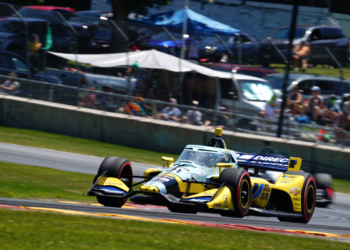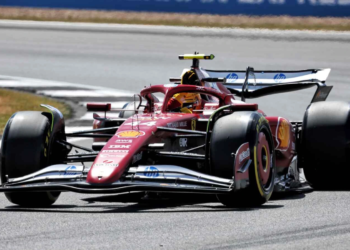There was a time when Sir Frank Williams was a joke figure in Formula 1. It seems odd, seven world drivers’ titles, nine constructors’ titles and 114 grand prix victories later. But, for years, he was perceived as a forever struggling presence near the back.
This weekend, Sir Frank’s 50 years as an F1 team boss is being marked, and the anniversaries don’t end there as the day of the British Grand Prix also is 40 years to the day since Williams’ first grand prix win, also at Silverstone for the British Grand Prix.
“You’ve got to remember that Frank’s reputation from his early efforts was not great,” Sir Frank’s long-time designer and right-hand-man Sir Patrick Head notes. “He was known as ‘W*nker’ Williams…everybody thought his cars were just there to fill up the grid.”
Williams in his freshman 1969 year had two second places running a privately-entered Brabham, with Piers Courage driving, but after that point it appeared that Frank, year after year, was condemned to salvaging what he could from his latest failed project.
And as all prepared for the 1978 season there seemed little reason to re-evaluate. He’d been sidelined by Walter Wolf, reduced to a glorified gofer. Then he returned in ‘77, heading his own operation again, with a long-in-the-tooth March and pay driver Patrick Neve. There was little to write home about.
However, Ken Tyrrell for one went against the consensus, saying as early as 1974 that “there’s no one in this paddock who wants to succeed more than [Frank Williams] does and if he ever gets himself financially organised, watch out…”.
He was known as ‘W*nker’ Williams…everybody thought his cars were just there to fill up the grid – Sir Patrick Head
And as the press was invited to the Williams factory in early ‘78 to view the new FW06 car, there were hints that Tyrrell was about to be proved prescient. The team had built its own car, penned by new designer Head, though Williams had tried that sort of thing before and it had hardly gone well. Head also was rather an unknown quantity.
Williams had also signed Alan Jones as driver, and Jones had won a race in fine style the previous year for Shadow in wet-dry Austria. Yet the Australian had been around for a while and was viewed as competent rather than top drawer.
But, as Maurice Hamilton observed among the press gathering, there was something different this time. “The place was spotless – something of a novelty for small racing teams in the 1970s,” he notes. Also “there was an unmistakable sense of purpose”.
Then there was the FW06 itself. By Head’s own admission, he didn’t at this point understand the ground effect that helped Lotus to five wins in ‘77, and would help it dominate ‘78. So Head instead aimed for “a simple, light, well-balanced car”. And it looked like he had achieved it.
Then there was the livery. For some time Frank had been camped in the Middle East looking to rustle up sponsors’ cash. As his late wife Virginia noted, “he’d go to Saudi Arabia for two days and come back two weeks later”.
While the 1977 Williams-entered car had a modest ‘Fly Saudia’ logo on its rear wing, the car now was resplendent in Saudia airline colours from front to back, and guests from the airline were in attendance. Tyrrell’s prediction suddenly looked like it would be tested.
I can’t say I saw Alan [Jones] as a future world champion when he joined us. It was the same with Patrick [Head]. I decided he was the guy to have with me because he was the best available – Sir Frank Williams
But it required more than sponsors and determination to affect an upturn. There was also a bit of magic.
“I can’t say I saw Alan [Jones] as a future world champion when he joined us, and, by the same token, I’m quite sure he didn’t see it in us,” Frank admits. “What we needed for 1978 was a good, sensible driver, who would finish regularly in the points. And that’s what I thought we were getting.
“It was the same with Patrick [Head]. When I split with Walter Wolf, I decided he was the guy to have with me because he was the best available. That was all. I simply didn’t appreciate his talents at the time.”
Few manager-designer-driver triumvirates have been as iconic or effective as Williams, Head and Jones. As Nigel Roebuck noted, “they sparked each other”; each of the trio inspired to much greater heights than likely any of them thought possible.
“We could hear the noise and the raised voices coming out of Frank’s office when Patrick was in there,” then-team manager Jeff Hazell recalls, “but it was all good stuff. And Alan was very single-minded and he became increasingly single-minded as he got some success.”
The alchemy worked. Eighteen months on Williams would win its first race, and dominantly. Two years later it’d be starting its double championship-winning year.
The FW06 wasn’t big on results, but was highly-rated. “The 06 showed a lot of promise,” Hazell notes. “It was probably the best non ground effect car and on some tracks like Long Beach where you don’t need a lot of downforce, because it’s slow-speed corners, it was very competitive, but we were unreliable.”
We could hear the noise and the raised voices coming out of Frank’s office when Patrick was in there, but it was all good stuff – Jeff Hazell
Indeed at Long Beach Jones looked a potential winner but his front wing started to collapse, then he developed a misfire.
“We had a lot of things wrong with that car and they were wrong because we were just new as a group,” Hazell continues. “At Long Beach we bent the front wing because it was off a March and it wasn’t tailor-made for the load path that we had in the car.
“We had an unreliable season, and the reason for that was we didn’t have enough industry experience, we weren’t bringing with us the industry standards from the motor industry. We didn’t have proper quality systems. They were sketchy at best.”
Yet this, conversely, proved key to the triumphant FW07 for 1979. As Head, knowing the team’s limitations, went for evolution not revolution. While some others, including reigning champion Lotus, overreached amid the ground effect revolution and produced cars that backfired.
“Patrick decided to effectively do a new car which was a copy of the Lotus basically,” adds then-chief mechanic Ian Anderson. “The FW07 was a copy of the Lotus, done better. Lotus cars tended to be too fragile; we did a very good job of improving the engineering. That’s where the concept came from, [we] just did a better job of it, it was an extremely good car.”
“There’s a sort of law of unintended consequences isn’t there?,” Hazell adds. “The consequence of not being much good in 1978 and being unreliable was Patrick said we’ve got to be a bit conservative here, and it paid off.”
In Belgium Jones led, but was side-lined with a maddening battery problem – Williams’ reliability woes not yet entirely ironed out. In Monaco he hunted down the leading Ferraris only to tag a barrier, but still his new-for-1979 team-mate Clay Regazzoni, who’d started 16th, chased winner Jody Scheckter to the flag.
The FW07 was a copy of the Lotus, done better. Lotus cars tended to be too fragile; we did a very good job of improving the engineering – Ian Anderson
And two rounds later, Silverstone’s British Grand Prix, breakthrough awaited.
These days, even a fairly rudimentary racing car will likely have fairings, but in 1979 it was new ground. The idea to seal off the low pressure area underneath the car close to the engine emerged from a young Frank Dernie, working for Williams in the Imperial College windtunnel. And its effect was stunning.
Jones’s best qualifying time – 1 minute, 11.88 seconds – sent a shiver right down the Silverstone pitlane. “The mods put on the car looked like a reasonable step, nothing more,” Frank admits. “But suddenly the car was going a bit quicker and a bit quicker.
“Then Alan came in and said, ‘You can’t believe what’s going on out there. It’s just unreal how quick it is’. Suddenly life was 100 per cent in another direction. I’ll never forget that feeling…Loads of people were looking at their stopwatches; I’ll never forget the despair on their faces.”
Jones, as expected, got pole and disappeared in the race, and team-mate Regazzoni before long was a comfortable, albeit distant, second.
But just after half-distance Jones’s water pump broke, leaving Regazzoni alone. Would the same problem strike down Regazzoni also? Was this old Williams unreliability returning to haunt them?
Thankfully not (helped by that Clay’s water pump was a different version to Jones’s). Regazzoni took the flag, and it was one of those rare F1 victories where everyone was pleased by the result, what with Frank’s years of struggle. Regazzoni, with class to throw away, knew this too. “Bravo Frank,” he said to his boss.
Suddenly life was 100 per cent in another direction. I’ll never forget that feeling…Loads of people were looking at their stopwatches; I’ll never forget the despair on their faces – Sir Frank Williams
“If we’d done the whole season [the FW07 didn’t debut until round five] I think we would have won the championship that season,” Anderson observes, “because towards the end of that year the car was extremely reliable and very very quick, but unfortunately it started very late and we had some unreliability early on. All those things were put right for 1980.
“For Frank and Patrick it was a bit like a dream season, we couldn’t do any wrong, the car was exceptionally reliable. Quite often we used to get to the track, sort a few things out and go back to the hotel because the car was ready to go. Great.
“A bit of a strange phenomenon for Frank, he wasn’t used to things like that, he got used to it very quickly though!”
Four wins were Jones’s before the ‘79 season’s end; many of them were demonstration runs. The next year, 1980, he won the drivers’ title and Williams the constructors’. The rest, as they say, is history.






